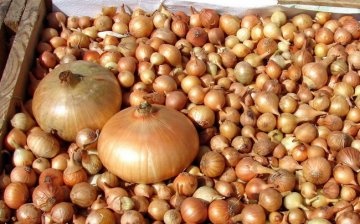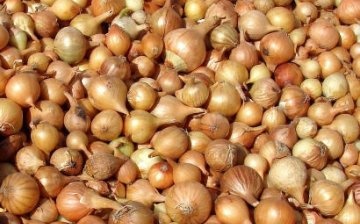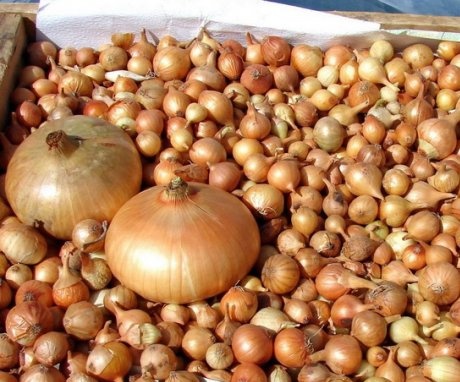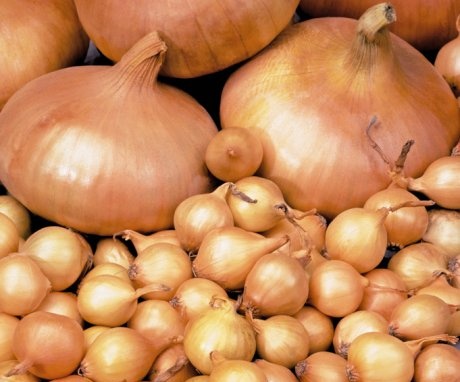Bow Stuttgarter Riesen
The Stuttgarter Riesen onion is the most popular onion among professionals and amateurs, which was bred by German breeders. What makes it so popular? Thanks to its excellent characteristics and ease of growing and care.
Content:
- Bow Stuttgarter Riesen and its description
- Stuttgarter Riesen onion and its cultivation
- Features in the care of onions Stuttgarter Riesen
Bow Stuttgarter Riesen and its description
The Stuttgarter onion is an early ripening onion. This bow is unsurpassed lying and quite fruitful... The time from the regrowth of the seedlings to the harvest of the onion takes about 65-75 days. Onion Stuttgarter Riesen has a yield of up to 8 kilograms per square meter. Its lightness and maturity are good.
Onions Stuttgarter Riesen are characterized by flat-round, firm, medium to large bulbs. The mass of onions reaches 50-100 grams. Dry scales are golden brown in color, while juicy scales are white in color.
Onions have a spicy taste. These bulbs can be used for freezing and drying due to their high dry matter content. Stuttgarter onions are suitable for all types of canning and home cooking. This onion is also great for forcing on a feather. Stuttgarter Riesen onion contains a lot of valuable vitamin C.
Onion Stuttgarter Riesen and its cultivation
Growing onions Stuttgarter is carried out through the set. The forerunners for onions can be cabbage, cucumbers, tomato, potatoes and legumes. Before planting, the seedlings must be sorted out, removing damaged and dry bulbs.
It would be nice to warm them up at a temperature of + 40-42 degrees for 8 hours. For this, even a conventional heating battery is suitable.
Immediately before planting, it is also important to soak the seedlings in water, which will be heated to + 35-42 degrees beforehand. Potassium manganese must also be added to the water (0.1 g per bucket) and aloe juice. In such a solution, the set should be for 24 hours. After that, it must be laid out on burlap or film.
Onions can be planted in early spring or autumn in pre-prepared beds. The distance between the grooves should be 10-15 centimeters. Planting depth should be up to two centimeters. After sowing, the soil should be slightly compacted. If necessary onion can be mulched with peat and humus, especially for autumn planting.
In addition, when planting in the fall, it is recommended to take a small set, since it dries up during storage until spring.
Small bulbs can be planted earlier than larger ones. Large bulbs will release arrows if they are not planted in soil heated to + 10-15 degrees. Onions can be planted before winter, then its ripening will be two weeks earlier.
As for planting onions on a feather, it is best to take culled sets and turnip onions. It is necessary to plant the bulbs tightly enough, while not covering it with earth, but leaving it on the surface. After planting, the onions are watered and covered with foil. For faster growth, you can feed with urea once.
Features in the care of onions Stuttgarter Riesen
- The soil.
Suitable soil is fertile loamy chernozem with a neutral reaction. For this type of onion, acidic soils are not suitable.
- Temperature.
Although this variety tolerates cold, it still prefers moderate and even elevated temperatures.
- Watering and fertilizing.
Moderate watering is recommended.Fertilizer is desirable to apply two weeks after planting. For this, mullein or bird droppings are used. You need to repeat the feeding after another three weeks. The third feeding is carried out during the formation of the bulbs.
It is not recommended to apply fresh manure under onions. This can lead to the fact that onion ripening will begin to slow down, and pests will also begin to develop rapidly.
- Disease control.
This onion is characterized by high resistance to downy mildew and arrow formation. Occasionally, embryo or nesting can be observed.
Often the cause of any disease is poor-quality planting material, so it is recommended to purchase it in specialized stores.
In preventive measures, it is also advisable to carry out the procedure for disinfecting seeds and seedlings. In addition, if you plant several dill bushes next to the onion and also alternate the beds of onions with beds of carrots, then you can thus fight the appearance of pests.
It is important to remember that with a lack of nitrogen, the onion will grow poorly and its color will be pale. With a lack of potassium, premature aging of the leaves and the appearance of wrinkles will begin. And with a lack of phosphorus, you can expect that the tops of the leaves will begin to blacken and die off. If such diseases occur, it is necessary to make the appropriate fertilizers.
So, growing Stuttgarter Riesen onions is not difficult at all and does not require much hassle. But there is an opportunity to get a wonderful harvest of a very valuable and useful product.














A good onion, you will not say anything. And it is actually quite popular with gardeners - you can always buy it from grannies in the market.